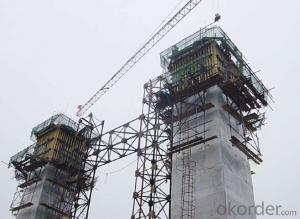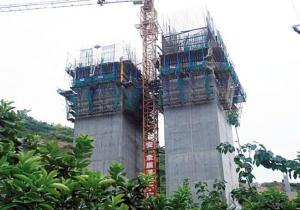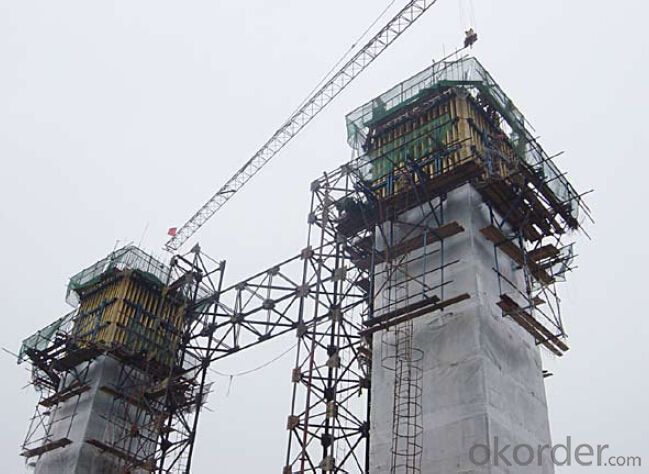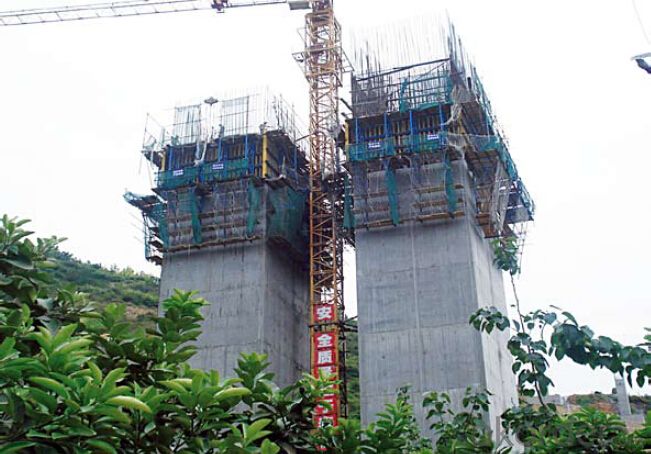Climbing Bracket for Formwork and Scaffolding system
- Loading Port:
- Tianjin
- Payment Terms:
- TT OR LC
- Min Order Qty:
- 50 m²
- Supply Capability:
- 1000 m²/month
OKorder Service Pledge
OKorder Financial Service
You Might Also Like
Climbing Bracket CB240 & CB210
They are framework brackets for supporting large-area wall formwork.
Typical applications for the CB240&CB210 are pier and column/shear wall/core walll/ in the
building.
CB210 has smaller size than CB240, it will be cost effective in some condition.
Characteristics:
◆ High bearing capacity
The high loading capacity of the brackets allow very large scaffold units. This saves the number
anchor points required as well as reducing climbing times.
◆ Simple moving procedure by crane
Through the strong connection of formwork together with the climbing scaffold, both can be moved
as a single climbing unit by crane. Thus valuable time-savings can be achieved.
◆ Fast striking process without a crane
With the retrusive set, large formwork elements can also be retracted quickly and a minimum of
effort.
◆ Safe with work platform
The platforms have assembled firmly with bracket and will be climbing together, without scaffolding
but can work safely in spite of your high location.
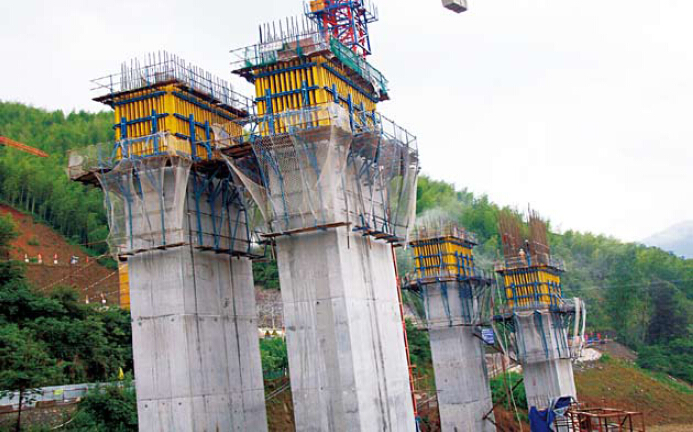
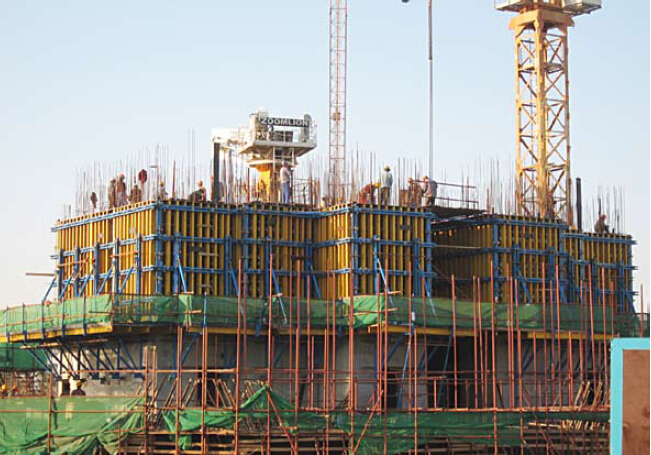
- Q: What are the safety precautions when working with steel formwork?
- When working with steel formwork, it is important to follow several safety precautions to ensure the well-being of workers. These precautions include wearing personal protective equipment (PPE) such as hard hats, safety glasses, gloves, and steel-toed boots. It is also crucial to inspect the formwork for any damages or defects before using it, as well as to secure it properly to prevent collapse or movement during construction. Adequate training and supervision should be provided to workers, and they should be cautious of potential hazards such as sharp edges, heavy lifting, and working at heights. Regular communication and adherence to safety protocols are key to minimizing accidents and ensuring a safe working environment.
- Q: What are the common design considerations for steel formwork in high-rise construction?
- There are several common design considerations for steel formwork in high-rise construction. First and foremost, the load-bearing capacity of the formwork must be carefully evaluated. High-rise constructions often involve heavy loads, including the weight of the concrete, equipment, and workers. Therefore, the steel formwork must be designed to withstand these loads and ensure the safety of the construction process. Another important consideration is the durability and longevity of the formwork. High-rise construction projects can take several months or even years to complete, so the formwork needs to be able to withstand prolonged use and exposure to various weather conditions. Steel formwork is preferred in high-rise construction due to its strength and resistance to wear and tear. The design of the formwork should also take into account the ease of assembly and disassembly. High-rise construction projects often require frequent repositioning of the formwork as the building progresses. Therefore, the formwork system should be designed in a way that allows for efficient and quick assembly and disassembly, minimizing downtime and increasing productivity. Additionally, the flexibility and adaptability of the formwork design is crucial in high-rise construction. The formwork needs to be able to accommodate different shapes and sizes of concrete elements, including columns, walls, and slabs. This requires a well-thought-out formwork system that can be easily adjusted and modified to meet the specific requirements of each construction phase. Furthermore, safety is a paramount consideration in high-rise construction. The formwork design should incorporate appropriate safety features such as handrails, guardrails, and non-slip surfaces to prevent accidents and ensure the well-being of workers. Lastly, cost-effectiveness is an important consideration. High-rise construction projects can be financially demanding, and the formwork design should aim to minimize material and labor costs without compromising on quality and safety. In conclusion, the common design considerations for steel formwork in high-rise construction include load-bearing capacity, durability, ease of assembly and disassembly, flexibility, safety, and cost-effectiveness. By addressing these factors, engineers and designers can ensure the successful and efficient execution of high-rise construction projects.
- Q: How does steel formwork affect the overall flexibility of the structure?
- A positive impact on the overall flexibility of a structure can be achieved through the use of steel formwork. Unlike traditional timber formwork, steel formwork is recognized for its strength, durability, and rigidity. These characteristics enable the construction of structures that are more robust and stable. The utilization of steel formwork enhances flexibility in terms of design and construction. Steel formwork systems are extremely adaptable and can be easily adjusted and modified to meet various project requirements. This adaptability allows for the development of intricate shapes and structures, including curved walls, while maintaining overall strength and stability. Furthermore, steel formwork offers a higher load-bearing capacity compared to alternative formwork materials. This increased strength permits the construction of taller and more expansive structures. The rigidity of steel formwork also reduces deflection and deformation, ensuring the structural integrity of the building. Moreover, steel formwork is renowned for its reusability. Unlike other formwork materials, steel formwork can be employed multiple times, resulting in a cost-effective solution. The reusability factor also contributes to the overall flexibility of the structure, as it facilitates easy dismantling and reassembly, allowing for any necessary modifications or renovations in the future. In conclusion, the strength, durability, and adaptability of steel formwork significantly enhance the overall flexibility of a structure. Its ability to handle complex designs, higher loads, and its reusability make it an ideal choice for construction projects, providing a solid foundation for creating flexible and resilient structures.
- Q: How does steel formwork handle different concrete early age strength development?
- Steel formwork is a versatile and durable material that is commonly used in construction for shaping and supporting concrete structures. When it comes to handling different concrete early age strength development, steel formwork demonstrates several advantages. Firstly, steel formwork provides excellent support and stability to the concrete during the initial stages of its curing process. This is crucial as the concrete gains strength and begins to harden. The rigid nature of steel formwork prevents any deformation or displacement, ensuring that the concrete retains its desired shape and structure as it sets. Additionally, steel formwork offers a high level of dimensional accuracy. This means that it can provide precise and consistent shapes and sizes to the concrete elements being constructed. This is particularly important during the early age strength development phase, as any variations or inconsistencies in the formwork could negatively impact the overall strength and integrity of the concrete. Furthermore, steel formwork is highly resistant to moisture and chemical reactions. Concrete undergoes a hydration process, where it absorbs water and undergoes chemical reactions to gain strength. Steel formwork, being non-absorbent, prevents excessive moisture from being absorbed by the concrete, which could lead to reduced strength development or even cracking. Additionally, steel formwork does not react chemically with the concrete, ensuring that the desired early age strength development is not compromised. Another advantage of steel formwork is its reusability. Unlike other formwork materials such as wood or plastic, steel formwork can be easily dismantled and reused for multiple construction projects. This not only reduces construction costs but also allows for consistent and reliable formwork performance, regardless of the concrete's early age strength development requirements. In conclusion, steel formwork is a reliable and efficient solution for handling different concrete early age strength development. Its stability, dimensional accuracy, resistance to moisture and chemical reactions, as well as its reusability, make it an ideal choice for shaping and supporting concrete structures during the crucial initial stages of curing.
- Q: How does steel formwork affect the overall durability of a construction project?
- Steel formwork can significantly enhance the overall durability of a construction project. Its robust and rigid nature helps in maintaining the structural integrity of the concrete elements being formed, resulting in stronger and more durable structures. Steel formwork is highly resistant to wear and tear, reducing the need for frequent replacements and ensuring long-term durability. Additionally, its ability to withstand high pressures and loads allows for the creation of complex and intricate structures, further enhancing the overall strength and durability of the construction project.
- Q: Can steel formwork be used for both residential and commercial projects?
- Steel formwork can serve both residential and commercial projects effectively. Renowned for its strength and capacity to bear heavy loads, steel formwork is a flexible and enduring choice extensively employed in construction. Its adaptability enables convenient customization to cater to diverse project demands, irrespective of whether they pertain to residential or commercial ventures. Among its merits are notable advantages like exceptional concrete finish, swift assembly, and extensive reusability. In both residential and commercial construction, steel formwork finds widespread application in foundations, walls, slabs, columns, and beams.
- Q: Can steel formwork be used for foundation walls?
- Yes, steel formwork can be used for foundation walls. Steel formwork is a durable and strong material that provides excellent support for concrete during the construction process. It can be used for both horizontal and vertical applications, including foundation walls. Steel formwork offers several advantages such as high load-bearing capacity, reusable nature, and ease of installation and removal. It allows for precise shaping of foundation walls and ensures a smooth and uniform finish. Additionally, steel formwork is resistant to moisture and can withstand harsh weather conditions, making it suitable for foundation walls in various environments.
- Q: How does steel formwork handle different concrete pumping methods?
- Steel formwork is highly versatile and can handle different concrete pumping methods with ease. The rigid and sturdy nature of steel formwork allows it to withstand the pressure and force exerted by various pumping techniques such as boom pumps, line pumps, and even placing concrete by gravity. Additionally, the smooth surface of steel formwork ensures that the concrete flows smoothly during the pumping process, resulting in a consistent and high-quality finish. Overall, steel formwork is well-suited for accommodating different concrete pumping methods and ensuring efficient and successful construction projects.
- Q: Are there any fire safety considerations when using steel formwork?
- Yes, there are fire safety considerations when using steel formwork. Steel is a non-combustible material, which means it does not catch fire or contribute to the spread of flames. However, during a fire, steel can lose its structural integrity and collapse more rapidly than other materials. Therefore, it is important to have proper fire protection measures in place, such as fire-resistant coatings or fireproofing materials, to ensure the safety of personnel and the structure when using steel formwork.
- Q: How does steel formwork handle formwork alignment and leveling?
- The steel formwork system is a highly efficient and versatile solution that excels in the management of formwork alignment and leveling. It possesses numerous features and mechanisms that guarantee precise and accurate formwork placement. To begin with, the robustness and rigidity of steel formwork enable it to maintain its shape and dimensions throughout the pouring and curing of concrete. This inherent stability ensures that the formwork remains aligned and level during the entire construction process. Furthermore, steel formwork often incorporates adjustable components like screws, wedges, and clamps. These elements allow for fine-tuning of the formwork's position and elevation, facilitating precise alignment and leveling. By simply adjusting these components, workers can easily rectify any deviations and ensure perfect formwork alignment. Additionally, steel formwork systems frequently utilize integrated leveling systems. These systems typically consist of hydraulic jacks or mechanical devices that provide controlled and precise leveling. By utilizing these mechanisms, workers can effortlessly adjust the formwork's height and maintain a consistent level across the entire structure. Moreover, steel formwork possesses the ability to withstand significant loads and pressures exerted by the concrete during pouring. This strength enables it to resist any deformation or deflection, ensuring that the formwork remains aligned and level even under challenging conditions. In conclusion, the steel formwork system offers exceptional capabilities in managing formwork alignment and leveling. Its inherent stability, adjustable components, integrated leveling systems, and strength make it a reliable choice for maintaining the desired accuracy and precision during concrete construction projects.
Send your message to us
Climbing Bracket for Formwork and Scaffolding system
- Loading Port:
- Tianjin
- Payment Terms:
- TT OR LC
- Min Order Qty:
- 50 m²
- Supply Capability:
- 1000 m²/month
OKorder Service Pledge
OKorder Financial Service
Similar products
Hot products
Hot Searches
